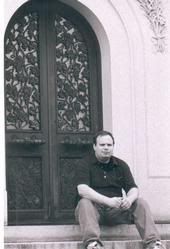Following the worldwide success of ZOMBIE (or ZOMBI 2 or ZOMBIE FLESH EATERS or whatever you want to call it), Lucio Fulci embarked on what could be called his "gothic period," firing off a trilogy of films (CITY OF THE LIVING DEAD, THE BEYOND, and HOUSE BY THE CEMETERY) in rapid succession. A mixed lot, all of which are slated for eventual review here, they're often regarded as Fulci's best work. The 1980 film CITY OF THE LIVING DEAD--best known stateside under the alternate, and more accurate, title THE GATES OF HELL--usually falls in the middle of critical reception, better received than HOUSE yet it never gets THE BEYOND's superlatives; it's also my favorite Fulci.
Sharing scripting duties with Dardano Sacchetti, Fulci drops the action into the sleepy hamlet of Dunwich, but don't expect the normal Lovecraftian hijinx here; in fact, there's very little of the man from Providence in this tale of a psychic (Catriona MacColl) and a detective (Christopher George) trying to close the recently opened doorway to Hell, an occurrence kick-started by the suicide of a priest. What powers CITY isn't its narrative but its evocative gothic atmosphere--utilizing soft, almost surreal photography and an ominous electronic score--and the strength of its individual shock set-pieces; that the two can work together is a testament to both Fucli's direction and Sergio Salvati's cinematography.
Not much about CITY makes any literal sense, yet the film operates under its own dream-like logic so that even the most idiotic plot twists seem natural (such as the living dead's ability to transport from one side of the room to another to claim their victim, a technique battered to death by later installments of the FRIDAY THE 13TH franchise that nonetheless retains a glint of effectiveness here). Often, the movie progresses like a series of stylishly-recreated nightmares, from the scene in which George "exhumes" a still-living MacColl from her grave to the gory highlights of the entrail-vomiting sequence and Giovanni Radice's drill-through-the-head (two moments that've given many a gorehound pause) before tying off its loose ends in a more conventional method. This dream-like feel helps save its open ending, which has sparked much debate about its true meaning--though it's really just a post-production trick to cover an editing goof.
For a movie that relies on the power of its imagery, it's a shame that Fucli felt it neccesary to crib from Dario Argento, most notably the rain of maggots that suggests the one in SUSPIRIA to the opening seance that recalls a similar scene from DEEP RED. The climax even borrows heavily from ZOMBIE's hospital stand-off, with both its zombies aflame and its mimicked score; whether this was to establish a thematic unity or to just redo what already worked is hard to say.
Still, this remains an all-time favorite. Maybe not as narratively coherent as ZOMBIE, but a lot more engaging than the oft-overrated THE BEYOND.
Tuesday, April 1, 2008
Subscribe to:
Post Comments (Atom)

No comments:
Post a Comment